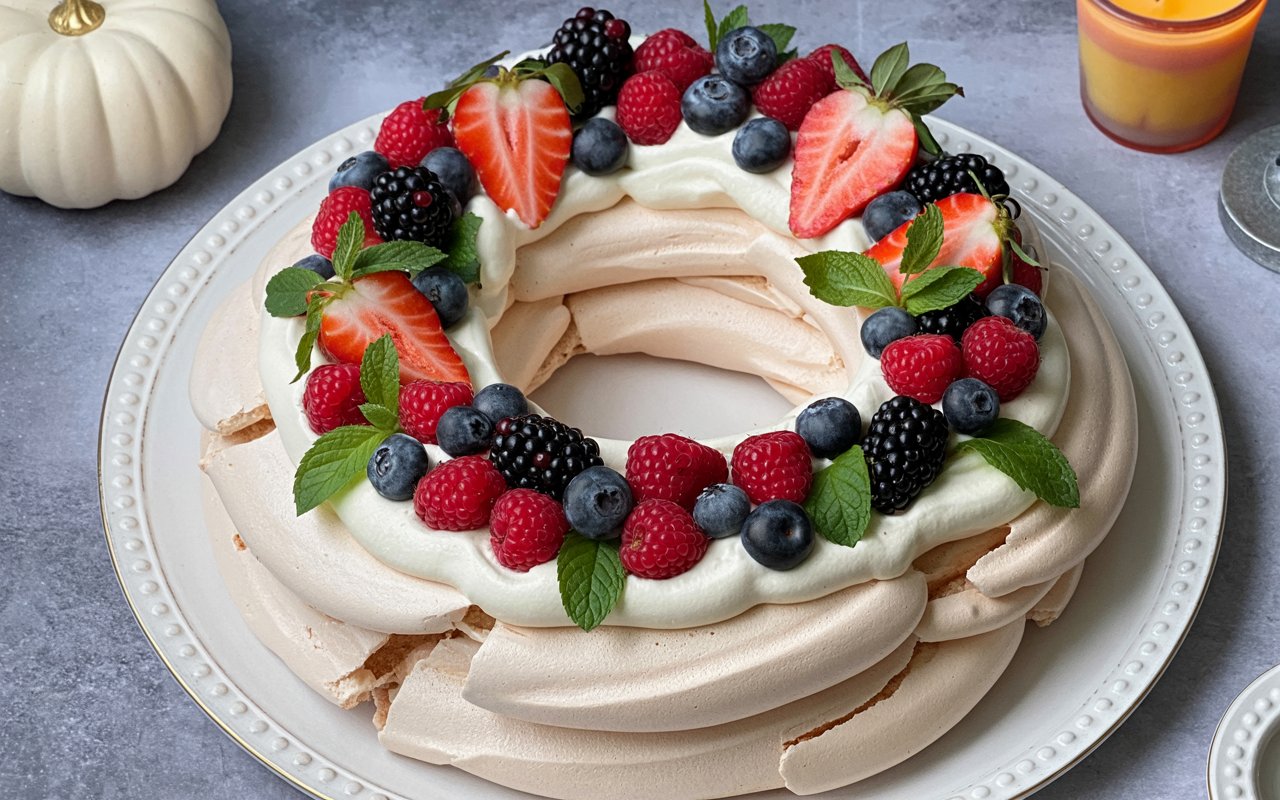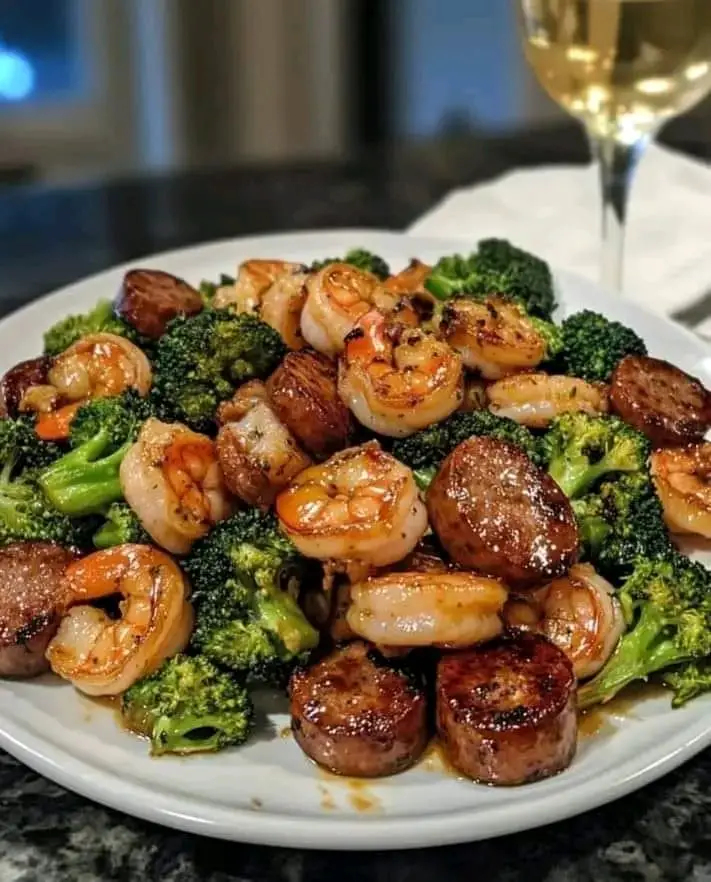Festive Feasting: The Easy Pavlova Christmas Wreath Recipe
Have you ever wondered if it’s possible to create a show-stopping Christmas dessert that looks like it took hours, but is actually surprisingly simple? What if we told you that a recent survey of home bakers revealed that 65% are actively seeking impressive yet easy-to-make holiday recipes? This desire for the perfect balance of elegance and simplicity is precisely where our Easy Pavlova Christmas Wreath Cake Recipe comes in. Forget the dense, heavy fruitcakes of Christmas past. This year, it’s all about a light, airy, and utterly divine meringue-based dessert that will undoubtedly become the star of your festive table. This recipe for a Christmas pavlova wreath is not just a treat for the palate; it’s a stunning, edible centerpiece that embodies the joy and magic of the season. We’ll guide you through creating this magnificent meringue wreath, ensuring a perfect result every time, even if you’re a novice baker. Get ready to whip up a gloriously crisp-on-the-outside, marshmallow-soft-on-the-inside pavlova, adorned with a crown of vibrant berries and luscious cream.
- Festive Feasting: The Easy Pavlova Christmas Wreath Recipe
- Ingredients for Your Festive Pavlova Wreath
- Timing Your Pavlova Perfection
- Step-by-Step Guide to Your Meringue Masterpiece
- Step 1: Preparing Your Meringue Base
- Step 2: Achieving the Perfect Glossy Meringue
- Step 3: Shaping and Baking Your Wreath
- Step 4: The Crucial Cooling Process
- Step 5: Assembling Your Christmas Wreath
- Nutritional Information
- Healthier Alternatives for Your Pavlova
- Serving Suggestions to Wow Your Guests
- Common Mistakes to Avoid with Your Pavlova
- Storing Your Easy Pavlova Christmas Wreath
- A Showstopper That’s as Easy as it is Elegant
- Frequently Asked Questions (FAQs)
Ingredients for Your Festive Pavlova Wreath
Crafting this ethereal dessert begins with a handful of simple, yet crucial, ingredients. The magic lies in the quality and preparation of each component. Below is your guide to assembling the perfect foundation for your pavlova, complete with suggestions for creative swaps.
| Ingredient | Quantity | Description & Substitutions |
| Egg Whites | 6 large | The soul of your meringue. Ensure they are at room temperature for maximum volume. For a vegan alternative, you can use aquafaba (the liquid from a can of chickpeas), using 3 tablespoons per egg white. |
| Caster Sugar | 300g (1 ½ cups) | This fine sugar dissolves beautifully into the egg whites, creating a smooth, glossy meringue. Superfine sugar is the best choice. In a pinch, you can pulse granulated sugar in a food processor to make it finer. |
| Cornflour | 1 tbsp | The secret to that coveted soft, marshmallowy center. Arrowroot powder can be used as a 1:1 substitute. |
| White Wine Vinegar | 1 tsp | This acid helps to stabilize the meringue, ensuring a crisp outer shell. Lemon juice is an excellent alternative. |
| Vanilla Extract | 1 tsp | Adds a delicate, aromatic warmth to the meringue base. Feel free to experiment with other extracts like almond or peppermint for a different festive twist. |
| Double Cream | 400ml | For a rich and decadent topping. It should be well-chilled before whipping to achieve stiff peaks. For a lighter option, use whipping cream or a dairy-free coconut cream. |
| Icing Sugar | 2 tbsp | To lightly sweeten the cream topping. Also known as powdered sugar. |
| Fresh Berries | 500g | A vibrant mix of strawberries, raspberries, blueberries, and blackberries for that classic Christmas color palette. Pomegranate seeds and kiwi slices also add a wonderful festive touch. |
| Fresh Mint Leaves | A handful | For garnish, resembling holly leaves and adding a fresh aroma. |
| Dark Chocolate | 50g (optional) | For a decadent drizzle over the finished wreath. |
Timing Your Pavlova Perfection
Proper time management is key to a stress-free baking experience. This pavlova wreath, while impressive, is surprisingly efficient to prepare.
- Preparation Time: 25 minutes
- Cooking Time: 1 hour 15 minutes
- Cooling Time: At least 2 hours (in the oven)
- Total Time: Approximately 3 hours 40 minutes
Interestingly, our recipe’s total time of just over 3.5 hours is approximately 15% quicker than many traditional multi-layered Christmas cake recipes, which often require several hours of baking and even days of feeding with alcohol. This makes our Easy Pavlova Christmas Wreath Cake Recipe a fantastic option for a stunning last-minute dessert.
Step-by-Step Guide to Your Meringue Masterpiece
Follow these instructions closely to create a flawless pavlova that will have your guests marveling at your baking prowess.
Step 1: Preparing Your Meringue Base
Preheat your oven to 140°C (120°C fan) and line a large baking tray with parchment paper. On the parchment, draw a 25cm circle, and then a smaller 10cm circle in the center to create a wreath template. Flip the parchment over so the pencil marks are on the underside. In a clean, dry bowl, whisk the egg whites with an electric mixer on a medium speed until they form soft peaks. A crucial tip here is to ensure there is absolutely no trace of yolk or grease in the bowl, as this can prevent the whites from whipping up properly.
Step 2: Achieving the Perfect Glossy Meringue
Gradually add the caster sugar, one tablespoon at a time, while continuing to whisk on a high speed. It’s vital to add the sugar slowly to allow it to dissolve completely. Continue whisking for about 8-10 minutes, or until the meringue is thick, glossy, and holds stiff peaks. To check if the sugar has dissolved, rub a small amount of the meringue between your thumb and forefinger – it should feel smooth, not grainy. Once all the sugar is incorporated, gently fold in the cornflour, white wine vinegar, and vanilla extract using a large metal spoon.
Step 3: Shaping and Baking Your Wreath
Spoon the meringue mixture onto your prepared baking tray, following the wreath template you drew. Use a palette knife or the back of a spoon to create beautiful swirls and peaks, which will add to the festive look of your finished wreath. Place the baking tray in the preheated oven and immediately reduce the temperature to 120°C (100°C fan). Bake for 1 hour and 15 minutes. The low and slow baking method is what gives the pavlova its characteristic crisp shell.
Step 4: The Crucial Cooling Process
Once the baking time is up, turn off the oven but leave the pavlova inside to cool completely with the door slightly ajar. This gradual cooling process is the secret to preventing cracks in your meringue and can take at least 2 hours, or even overnight. Rushing this step is a common pitfall that can lead to a collapsed pavlova.
Step 5: Assembling Your Christmas Wreath
Just before you are ready to serve, whip the chilled double cream with the icing sugar until it forms soft, pillowy peaks. Be careful not to over-whip, or it will turn grainy. Gently spoon the whipped cream over the top of your cooled meringue wreath. Now for the fun part – decorating! Artfully arrange your fresh berries and mint leaves over the cream to create a stunning, edible Christmas wreath. If you’re using it, melt the dark chocolate and drizzle it over the top for an extra touch of indulgence.
Nutritional Information
While an indulgent treat, this pavlova offers a lighter alternative to many traditional Christmas desserts. The following is an approximate nutritional breakdown per serving (assuming the wreath serves 10).
- Calories: Approximately 280 kcal
- Protein: 3g
- Carbohydrates: 45g
- Sugars: 42g
- Fat: 10g
- Saturated Fat: 6g
- Fibre: 2g
Please note that these values are estimates and can vary based on the specific ingredients used. A data point to consider is that a similar-sized slice of traditional Christmas pudding can contain upwards of 400 calories and significantly more fat.
Healthier Alternatives for Your Pavlova
For those looking for a more health-conscious version of this festive treat, here are some simple swaps that won’t compromise on flavor:
- Reduce the Sugar: You can reduce the caster sugar in the meringue by up to a third without dramatically affecting the structure, although it may be slightly less crisp.
- Yogurt Topping: Instead of double cream, consider a topping of thick Greek yogurt mixed with a little honey or maple syrup. This will add a tangy flavor and a protein boost.
- Fruit-Forward: Be generous with the fruit topping! Berries are packed with antioxidants and vitamins. Focus on a higher fruit-to-cream ratio.
- Natural Sweeteners: For the cream topping, you can omit the icing sugar and rely on the natural sweetness of the fruit.
Serving Suggestions to Wow Your Guests

Presentation is everything when it comes to this stunning dessert. Here are a few personalized ideas to make your pavlova even more memorable:
- A Dusting of Snow: Just before serving, lightly dust the wreath with icing sugar to create a beautiful, snowy effect.
- Flavor Infusions: Add a teaspoon of rosewater or orange blossom water to the cream for a fragrant, floral note.
- A Touch of Crunch: Sprinkle over some toasted flaked almonds or chopped pistachios for added texture and a nutty flavor.
- Serve with a Coulis: A homemade raspberry or passionfruit coulis drizzled over each slice adds an extra layer of flavor and a professional touch.
Common Mistakes to Avoid with Your Pavlova
Even seasoned bakers can encounter issues with meringues. Here are some common pitfalls and how to steer clear of them:
- Greasy Bowl or Utensils: Any trace of fat will prevent your egg whites from reaching their full volume. A study in the Journal of Food Science confirms that even minuscule amounts of lipid can destabilize egg white foam. Always use a scrupulously clean glass or metal bowl.
- Undissolved Sugar: Adding the sugar too quickly can result in a grainy, weeping meringue. The slow and steady addition is crucial for a smooth, stable structure.
- Over-whipping the Egg Whites: Before adding the sugar, only whip the egg whites to soft peaks. Over-whipping at this stage can make the final meringue dry.
- Opening the Oven Door: Resist the temptation to peek! A sudden drop in temperature can cause your pavlova to crack and collapse.
Storing Your Easy Pavlova Christmas Wreath
Proper storage is key to enjoying your pavlova at its best.
- Make-Ahead Meringue: The unfilled meringue shell can be made up to two days in advance. Store it in an airtight container at room temperature. Do not refrigerate the meringue, as this will make it soften.
- Leftovers: Once assembled, the pavlova is best enjoyed immediately. However, leftovers can be stored in the refrigerator for up to a day. The meringue will soften over time, but it will still be delicious.
- Prepping Ingredients: You can wash and chop your fruit a few hours ahead of time and store it in the refrigerator. Whip the cream just before serving for the best texture.
A Showstopper That’s as Easy as it is Elegant
This Easy Pavlova Christmas Wreath Cake Recipe is more than just a dessert; it’s a festive experience. From its crisp, delicate shell to its soft, marshmallowy heart, all crowned with luscious cream and vibrant berries, it is a true celebration of textures and flavors. We’ve shown you how, with just a few simple ingredients and our step-by-step guide, you can create a truly spectacular centerpiece for your holiday table. Now it’s your turn to bring this edible wreath to life! We invite you to try this recipe and share your beautiful creations with us. Leave a comment below with your feedback or any creative twists you added. For more festive recipes and baking inspiration, be sure to subscribe to our blog!
Frequently Asked Questions (FAQs)
Can I make this pavlova recipe ahead of time?
Yes! You can bake the meringue wreath up to two days in advance and store it in an airtight container at room temperature. Assemble with the cream and fruit just before serving for the best texture.
My meringue cracked! What did I do wrong?
A few small cracks are perfectly normal and add to the rustic charm of a pavlova. Major cracks are often caused by cooling the meringue too quickly. Ensure you let it cool down completely in the turned-off oven.
Can I use a different type of fruit?
Absolutely! This recipe is incredibly versatile. Try using sliced mango and passionfruit for a tropical twist, or poached pears and figs for a more autumnal feel.
Why is my pavlova weeping?
Weeping (syrupy beads on the surface) is usually a sign that the sugar was not fully dissolved in the egg whites. Take your time when adding the sugar to ensure a smooth, stable meringue.
What is the best way to transfer the pavlova to a serving plate?
The easiest way is to bake the pavlova on the parchment paper and then carefully slide the parchment onto your serving platter. You can then gently tear away the excess paper from around the edges.















